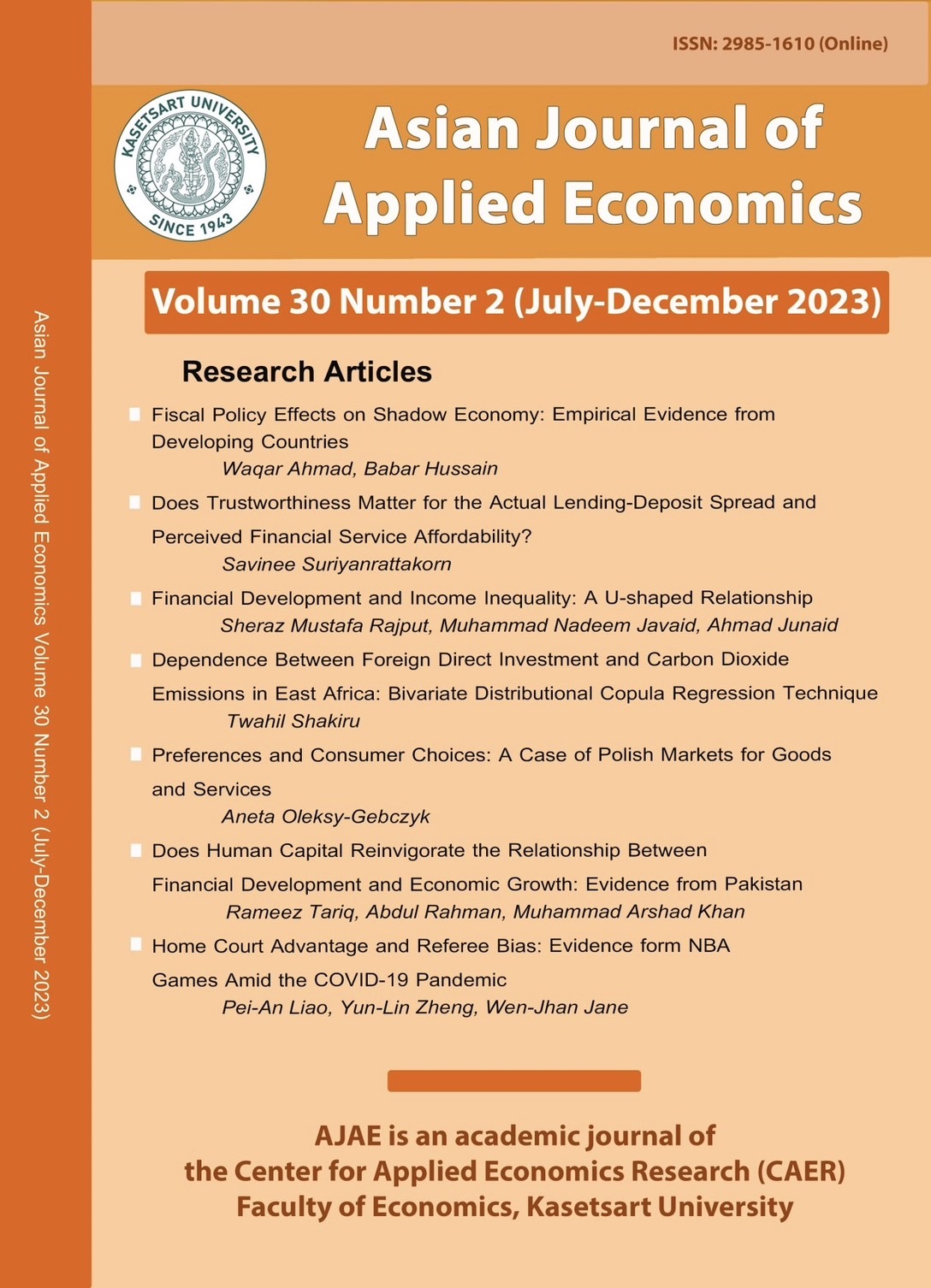Does Trustworthiness Matter for the Actual Lending-Deposit Spread and Perceived Financial Service Affordability?
Main Article Content
Abstract
Trustworthiness in financial systems is widely recognized as a crucial factor in fostering financial market efficiency. This research delves into the influence of trustworthiness in financial markets on both the perceived and actual costs of the financial system, drawing upon an eleven-year panel (2007-2017) encompassing 136 countries. The data was obtained from the Global Financial Development (GFD) and World Economic Forum Global Competitiveness Index (GCI). The study assesses the cost of financial systems through two key indicators: the bank lending-deposit spread and the perception of affordability in financial services. Additionally, this paper introduces a novel trustworthiness index from the GCI for estimation purposes. Three methodologies - fixed effect model, random effect model, and two-stage procedure - are applied. The findings reveal that trustworthiness shows an insignificant negative relationship with the bank lending-deposit spread. However, trustworthiness in financial systems positively impacts the perception of the cost of financial services across the overall sample, as it aids in cost reduction for financial transactions and enhances the affordability of financial services. As evident, enhancing trustworthiness within financial systems can effectively reduce the perceived cost of financial services. Policymakers should direct their efforts towards fostering trustworthiness in financial systems by implementing measures that prioritize transparency and accountability practices.
Article Details

This work is licensed under a Creative Commons Attribution-NonCommercial-NoDerivatives 4.0 International License.
The paper is published under CC BY-NC-ND, in which the article is freely downloaded and shared in its original form non-commercially and its citation details are identified.
References
Agapova, A., & McNulty, J. (2016). Interest rate spreads and banking system efficiency: General considerations with an application to the transition economies of Central and Eastern Europe. International Review of Financial Analysis, 47, 154-165.
Álvarez-Botas, C., & González, V. M. (2021). Does trust matter for the cost of bank loans? Journal of Corporate Finance, 66, 101791.
Blommestein, H.J. (2006). How to restore trust in financial markets? In P.H. Dembinski, C. Lager, A. Cornford & J.M. Bonvin (Eds.), Enron and World Finance (pp.180-190). London: Palgrave Macmillan.
Butter, F. A. G. den, & Mosch, R. H. J. (2003). Trade, trust, and transaction cost (Tinbergen Institute Discussion Papers No. 03-082/3). Retrieved from https://research.vu.nl/en/publications/trade-trust-and-transaction-costs
Chamberlain, G. (1980). Analysis of covariance with qualitative data. The Review of Economic Studies. 47(1), 225-238.
Calice, P., & Zhou, N. (2018). Benchmarking costs of financial intermediation around the world (World Bank Policy Research Working Paper Series No. 8478). Retrieved from https://papers.ssrn.com/sol3/papers.cfm?abstract_id=3238312
Chan, K., Kuo, W., Lin, C.-Y., & Lin, T.-C. (2020). Firm trustworthiness and bank loan pricing (SSRN Scholarly Paper ID 3535237). Retrieved from https://papers.ssrn.com/sol3/papers.cfm?abstract_id=3535237
Demirguc-Kunt, A., & Levine, R. (2000). Bank concentration: Cross-country evidence. Retrieved from https://documents1.worldbank.org/curated/en/979371468780328170/pdf/wdr27828.pdf
Demirgüç-Kunt, A., & Klapper, L. (2012). The impact of trust on financial service affordability (World Bank Policy Research Working Paper No.6185). Retrieved from https://www.worldbank.org/en/topic/financialinclusion/brief/how-to-measure-financial-inclusion
Dyer, J. H., & Chu, W. (2003). The role of trustworthiness in reducing transaction costs and improving performance: Empirical evidence from the United States, Japan, and Korea. Organization Science, 14(1), 57–68.
Gelos, R. G. (2009). Banking spreads in Latin America. Economic Inquiry, 47(4), 796–814.
Glaeser, E. L., & Gyourko, J. (2005). The impact of building restrictions on housing affordability (SSRN Scholarly Paper ID 790487). Retrieved from https://papers.ssrn.com/sol3/papers.cfm?abstract_id=790487
Greene, W.H. (2002), Econometric analysis. New York: Prentice Hall.
Gropp, R., Kok, C., & Lichtenberger, J.-D. (2014). The dynamics of bank spreads and financial structure. Quarterly Journal of Finance, 4(4), 1450014.
Guiso, L., Sapienza, P., & Zingales, L. (2008). Trusting the stock market. The Journal of Finance, 63(6), 2557–2600.
Hossain, M. (2010). Financial reforms and persistently high bank interest spreads in Bangladesh: Pitfalls in institutional development? (MPRA Paper No. 24755). Retrieved from https://mpra.ub.uni-muenchen.de/24755/
Howorth, C., & Moro, A. (2012). Trustworthiness and interest rates: An empirical study of Italian SMEs. Small Business Economics, 39(1), 161–177.
La Porta, R., Lopez-de-Silanes, F., Shleifer, A., & Vishny, R. (2008). Trust and financial inclusion: Evidence from a cross-country survey. Journal of Finance, 63(2), 265–300.
Mujeri, M. K., & Younus, S. (2009). An analysis of interest rate spread in the banking sector in Bangladesh. The Bangladesh Development Studies, 32(4), 1–33.
OECD. (2017). OECD guidelines on measuring trust. Paris: OECD Publishing.
OECD (2019). OECD business and finance outlook 2019: Strengthening trust in business. Paris: OECD Publishing.
Shin, J. (1985). Perception of price when price information is costly: Evidence from residential electricity demand. The Review of Economics and Statistics, 67(4), 591-598.
The International Monetary Fund. (2003). World economic outlook, April 2003: Growth and institutions. Retrieved from https://www.imf.org/en/Publications/WEO/Issues/2016/12/30/World-Economic-Outlook-April-2003-Growth-and-Institutions-16369


